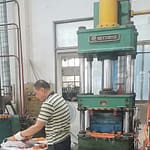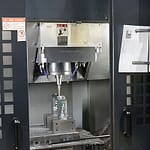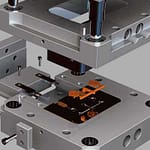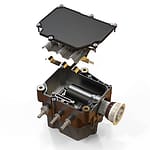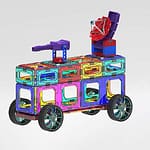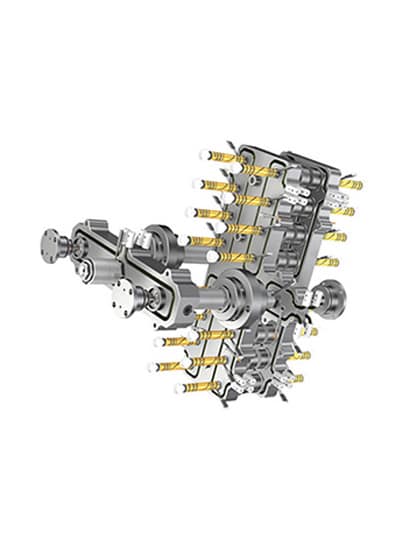Hot Runner injection mold
An effective process typically starts by milling or turning mold-forming material, followed by heat treating (in the case of hardened steel), grinding, refined shaping, and finishing treatments like polishing. Once all components have been assembled, care must be taken to ensure it will deliver its intended effects on workpieces.
Hot Runner Injection mold Advantages
Although there will be an ongoing need for cold runner molds, the advantages of using hot runner injection mold systems are so great that they will increasingly be the runner technology of choice for molds used in molding thermoplastics.
The key advantages are:
Reduced Material Waste
Hot runner systems render the need for a cold runner obsolete. A cold runner is a conduit that transports molten plastic material to the mold cavities. In a hot runner system, the plastic material remains molten within the hot runner manifold, thereby minimizing or even eliminating the creation of waste material. This results in substantial material savings and a reduction in production costs. As materials grow more sophisticated and costly, the cold runner consequently becomes expensive waste. The possibility of reusing the runner is uncertain, and in numerous medical and food applications, it is not an option. The process of regrinding and storing the runners incurs significant costs and creates noise and dust. In high-speed, high-cavitation molding operations, the scrap and regrind would pose enormous challenges. However, these regrind issues and their associated costs are non-existent when using hot runners.
Short Cycle Time/ Cost Reduction
In most cases, the cold runner weighs up to half of the total shot weight and typically possesses a section much thicker than the molded part wall thickness. The elimination of the cold runner reduces the cycle time, as the cooling time is controlled by the thickest section. Additionally, the injection screw recovery and injection times experience further cycle time savings due to the smaller shot size.
Molding Efficiency
Hot runner molds offer the advantage of easier startup compared to cold runner molds. This is due to the absence of solidified runners that need to be removed after each under-filled shot before achieving a full mold shot and enabling automatic cycling. The mold is ready for operation with hot runner systems once it reaches the operating temperature. Furthermore, hot runner systems generally allow for lower injection pressures, resulting in reduced mold and platen deflection, as well as minimal flash caused by mold component movement.
Optimal Part Quality
Eliminating the cold runner improves filling and packing conditions by preventing heat loss and pressure drops. Hot runner systems maintain a balanced melt flow, ensuring complete cavity filling and packing. This allows molders to leverage accurate and interchangeable cavities for precise plastic part dimensions. If a cavity is damaged or out of specification, reducing heat to the hot runner nozzle easily prevents the production of faulty parts.
Automating
A growing number of companies are adopting automation of plastics molding and assembly, leading to a rising demand for highly accurate and flash-free plastic parts. When utilized with automation, hot runner molds offer a clear advantage. In addition to ensuring dimensional consistency of the parts, hot runner molds do not have runners present that could become entangled in the mold mechanisms, robots, conveyors, assembly machinery, and other automated systems.
Design Flexibility
One significant advantage of hot runners, often overlooked, is their capability to position the gate at various points on the part. By utilizing hot tip gating, valve gating, or edge gating, hot runner systems enable the gate to be situated at the most advantageous location for optimal filling and/or enhanced part aesthetics. This flexibility provided by hot runners extends to both the part design and the mold itself. The ability to choose the gate location offers flexibility in optimizing cavity orientation, cooling, and simplification of the mold.
Types of Hot Runner Systems
There are several types of hot runner systems used in plastic injection molding, each designed for different applications based on the complexity of the mold, the number of cavities, and the specific requirements of the molding process. The main types of hot runner systems are as follows:
| Type | Description | Best For | Advantages | Disadvantages |
| Open-Loop Hot Runner | Heated sprue directs plastic to the mold cavity. | Low-volume or simple molds. | Simple and cost-effective. | Material waste due to non-recyclable sprue. |
| Closed-Loop Hot Runner | Heated manifold system for multi-cavity molds. | High-volume, multi-cavity molds. | Efficient, low material waste. | Higher cost and complexity. |
| Hot Sprue System | Only the sprue is heated, keeping it molten before injection. | Simple, small molds with few cavities. | Simple design, low cost. | Material waste in the sprue. |
| Valve Gate Hot Runner | Uses a valve to control the flow of molten plastic. | Precision parts, complex designs. | Precise flow control, reduces flash. | More complex, higher cost. |
| Sequential Hot Runner | Injects plastic into each cavity sequentially. | Multi-cavity molds with complex filling. | Ensures uniform filling and quality. | Complex design and control. |
| Multifunctional Hot Runner | Multiple hot runners for different materials or parts. | Multi-material or multi-color molding. | Allows complex designs. | Expensive and complex. |
| Co-Injection Hot Runner | Multiple materials injected into the same part. | Multi-material molding. | Enables multi-layer parts. | High cost and complex setup. |
| Hot Runner with Needle Valve | Uses a needle valve for precise flow control. | High-precision molding. | Very precise control, prevents defects. | High complexity and cost. |
What is the difference between a hot sprue and a hot runner in plastic injection molding?
The terms hot sprue and hot runner are often used interchangeably, but they refer to different components in a plastic injection molding system.
1. Hot Sprue:
Definition: A hot sprue is a heated component of the sprue system that maintains the molten plastic at the optimal temperature before it enters the mold cavity. This term typically refers to the nozzle or sprue bushing, where the material exits the injection molding machine and flows into the mold.
Function: It keeps the material in the sprue system in a molten state, preventing premature solidification, and ensures a consistent flow of plastic into the cavity. The primary objective is to reduce waste and improve cycle time by ensuring the material does not cool before injection.
Location: Found at the point where the plastic enters the mold.
2. Hot Runner:
Definition: A hot runner system is a more extensive setup that includes heated channels, known as runners, which transport molten plastic to the mold cavities. In a hot runner system, both the sprue and runners are heated; at times, the manifold, which distributes plastic to multiple cavities, is also included.
Function: Hot runners help minimize material waste since there is no need to eject the runners after each cycle. The plastic in the hot runner system remains molten throughout the injection cycle, ensuring it flows smoothly into the mold cavities.
Location: The mold incorporates the hot run system, which delivers molten plastic to all cavities through heated channels.
Here’s a comparison table that highlights the differences between hot sprue and hot runner systems in plastic injection molding:
| Feature | Hot Sprue | Hot Runner |
| Definition | Heated component at the entry point of the mold to keep the plastic molten. | A complete system that includes heated sprue, runners, and possibly the manifold for multiple cavities. |
| Function | Prevents plastic from cooling and solidifying at the sprue, ensuring smooth flow into the mold. | Maintains molten plastic through a heated system for efficient flow to multiple cavities, reducing waste. |
| Scope | Refers specifically to the heated sprue or nozzle. | Includes heated sprue, runners, and manifold (delivers molten plastic to all cavities). |
| Material Waste | Results in material waste because the sprue is discarded after each cycle. | Reduces material waste as the plastic in the hot runner system is reused during each injection cycle. |
| Complexity | Simpler system, used for molds with fewer cavities. | A more complex system, typically used for multi-cavity molds. |
| Cost | Lower cost due to simpler design and fewer components. | Higher cost due to complexity and additional components (heated channels, control systems). |
| Application | Best suited for molds with fewer cavities or simpler designs. | Ideal for multi-cavity molds where reducing material waste and improving efficiency is essential. |
| Mold Design | Easier to design with fewer parts involved. | More advanced mold design, requires additional considerations for heating and control systems. |
| Maintenance | Generally, maintenance is lower as it involves fewer components. | Requires more maintenance due to the system’s complexity and need for precise temperature control. |
| Energy Efficiency | Less energy-efficient as the sprue material cools down after each cycle. | More energy-efficient, as the heated plastic in the hot runner system remains molten and can be reused. |
This table provides a side-by-side comparison of the two systems to help clarify their differences and applications in plastic injection molding.

